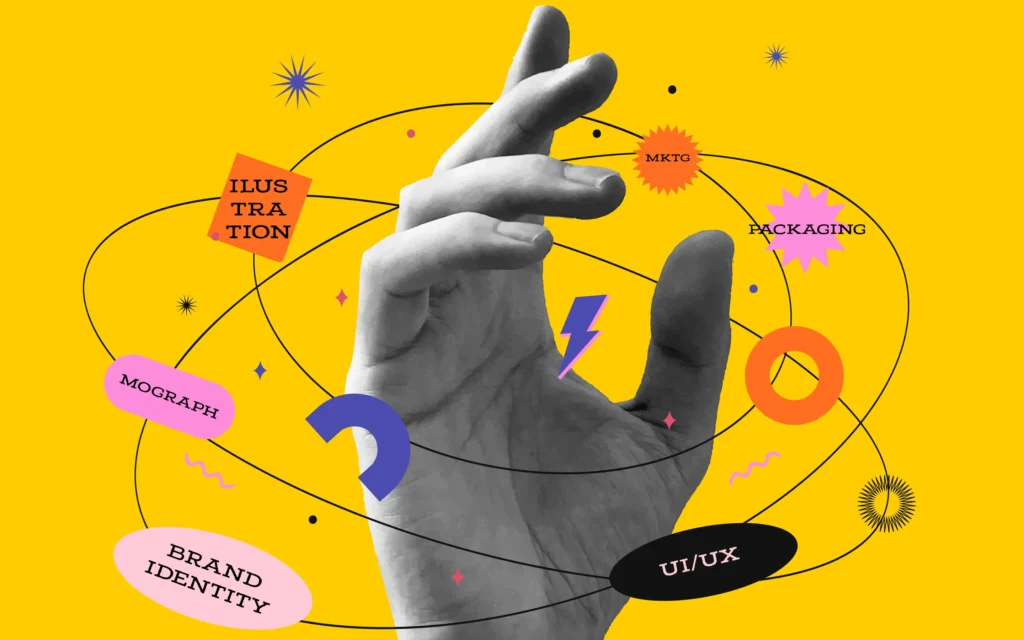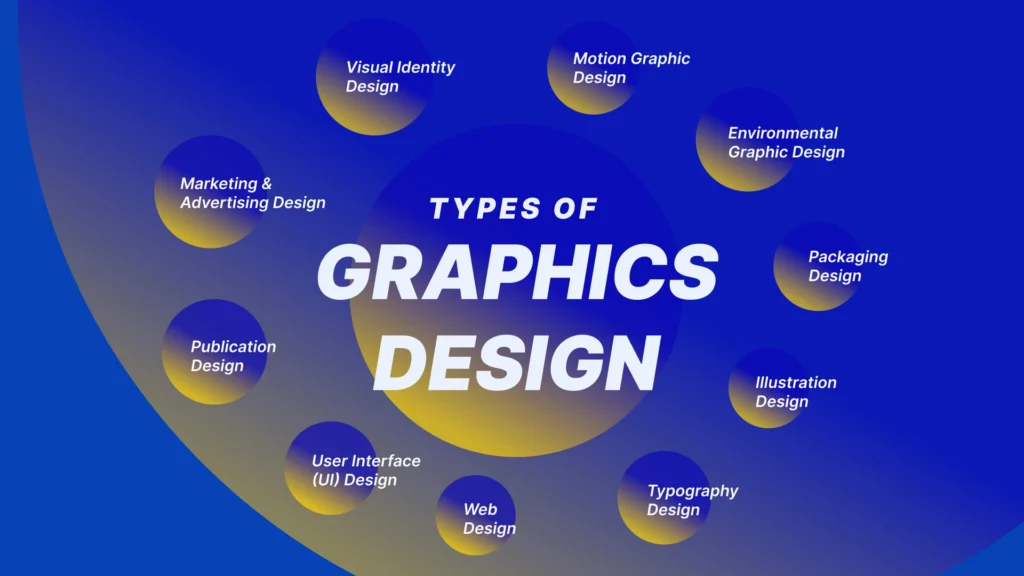
What is Graphic Design?
Graphic design is a vibrant and inventive discipline that entails the thoughtful amalgamation of visual components to communicate messages, concepts, and feelings with efficacy. It combines typography, color theory, imagery, and layout principles to produce visually striking and significant compositions. This area of expertise is vital in numerous fields, such as marketing, advertising, digital media, web design, publishing, and product packaging. In this blog we will mainly focus on the Types of Graphic Design.
Fundamentally, types of Graphic Design act as a potent means of communication, allowing businesses and organizations to create a unique brand identity, connect with their intended audience, and convey intricate information in a visually appealing and comprehensible manner. Whether it’s logos, brochures, websites, social media graphics, or product labels, effective types of Graphic Design improve user experience, promote brand awareness, and create a memorable impact.

What Are the 7 Types of Graphic Design?
Graphic design is a broad field that consists of several specialized areas. Here are the seven main types of Graphic Design:
- Visual Identity Graphic Design – Focuses on brand identity, including logos, color schemes, typography, and brand guidelines to create a cohesive look.
- Marketing & Advertising Design – Includes social media graphics, brochures, flyers, posters, and online ads that promote products or services.
- User Interface (UI) Design – Deals with designing digital interfaces for websites, apps, and software to enhance user experience.
- Publication Graphic Design – Encompasses magazine layouts, book covers, newspapers, and digital publications.
- Packaging Design – Involves creating visually appealing and functional packaging for products.
- Motion Graphics Design – Focuses on animated graphics, video content, GIFs, and other multimedia elements.
- Environmental Graphic Design – Includes signage, wayfinding systems, murals, and branded spaces to enhance physical environments.
1. Visual Identity Graphic Design
A company’s visual identity defines how it presents itself to the world. Graphic designers specializing in brand identity work on elements such as logos, typography, and color palettes to maintain brand consistency. A strong brand identity helps businesses establish credibility and recognition.
2. Marketing & Advertising Graphic Design
Marketing design plays a crucial role in attracting and engaging audiences. It includes digital and print materials such as social media graphics, email newsletters, online advertisements, and billboards. Effective marketing design uses compelling visuals and persuasive messaging to influence purchasing decisions.
3. User Interface (UI) Design
UI design focuses on enhancing user experience by making digital platforms intuitive and visually appealing. UI designers work on website layouts, mobile app interfaces, and software dashboards, ensuring that navigation is seamless and user-friendly.
4. Publication Graphic Design
This type of design is used in traditional and digital publishing. Graphic designers in this field create visually engaging layouts for magazines, newspapers, eBooks, and newsletters. Typography, imagery, and spacing are key elements in publication design.
5. Packaging Design
Product packaging plays a crucial role in consumer decisions. Packaging designers create attractive, informative, and functional packaging that not only protects the product but also appeals to customers. Packaging design combines graphics, material choices, and branding elements to create a lasting impression.
6. Motion Graphics Design
Motion graphics designers work with animation, video, and multimedia to bring content to life. These designs are commonly used in social media videos, explainer animations, TV commercials, and video games. Motion graphics enhance storytelling and captivate audiences effectively.
7. Environmental Graphic Design
Environmental graphic design improves the experience of physical spaces. It includes signage, wall murals, exhibition designs, and office branding to create immersive and informative environments. This type of design is often seen in museums, airports, and retail stores.
Emerging Trends in Graphic Design
With rapid advancements in technology, the graphic design industry is constantly evolving, introducing innovative trends that redefine visual communication. Designers are embracing new tools and techniques to create more engaging, efficient, and aesthetically refined experiences. Below are some of the most prominent trends shaping the future of the types of Graphic Design:
- AI-Powered Design Tools
Artificial Intelligence (AI) is revolutionizing the design process by automating repetitive tasks and offering intelligent suggestions. These tools assist designers in generating layouts, selecting color palettes, and optimizing compositions with greater precision. AI-powered platforms not only enhance efficiency but also enable designers to explore new creative possibilities with minimal effort. - Minimalist Design
The principle of “less is more” continues to influence contemporary design. Minimalist aesthetics prioritize simplicity, clean lines, and uncluttered compositions, creating visually appealing and easy-to-navigate designs. This trend emphasizes the use of ample white space, limited color schemes, and functional typography to convey messages effectively while maintaining an elegant and modern look. - 3D and Augmented Reality (AR) Design
The integration of three-dimensional elements and augmented reality is transforming the way users interact with digital content. 3D design brings depth and realism to visual compositions, making graphics more dynamic and immersive. Meanwhile, AR technology allows designers to create interactive experiences that bridge the gap between digital and physical spaces, enhancing user engagement in fields such as advertising, branding, and user interface design.
As these trends continue to evolve, graphic designers must adapt and incorporate emerging technologies to stay ahead in the competitive industry.
Selecting the Ideal Graphic Design Type to Suit Your Specific Needs
To select the most suitable graphic design type, you must fully grasp your goals and how you want your visual content to affect others. Investing in visual identity design is crucial if your main aim is to create or improve your brand’s identity. This category encompasses the creation of logos, typographic styles, color schemes, and other components that establish a unified and identifiable brand presence.
Conversely, if your aim is to boost engagement across digital platforms, marketing and motion graphics design might prove more advantageous. Marketing design includes promotional items like social media graphics, ads, and email campaigns, whereas motion graphics consist of animated visuals that engage audiences and convey messages in a dynamic way. By aligning your graphic design choice with your specific goals, you can effectively strengthen your brand and maximize engagement with your target audience.
Conclusion
Graphic design is a vibrant and diverse field that is constantly developing, influencing how we communicate and engage with brands. It acts as a potent means for delivering messages, building brand identities, and improving visual attractiveness on different platforms. When businesses and designers grasp the various forms of graphic design, they can make informed choices that are in line with their particular goals. No matter if the aim is to create a unique and unforgettable logo, devise a convincing and eye-catching marketing campaign, or develop a website interface that is both user-friendly and captivating, there exists a specialized area of graphic design dedicated to fulfilling each requirement. Ultimately, graphic design is not just about aesthetics—it is a strategic element that influences perception, strengthens brand presence, and drives engagement in an increasingly digital and visually driven world.